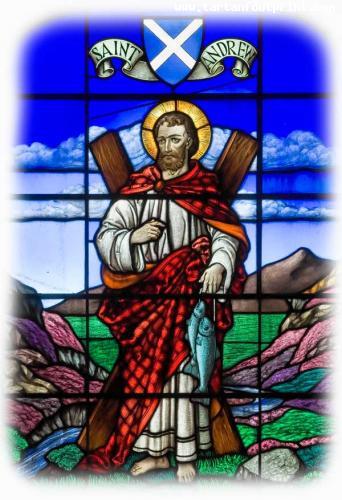You seem to be using an older version of Internet Explorer. This site requires Internet Explorer 8 or higher. Update your browser here today to fully enjoy all the marvels of this site.
May 27, 2018 by Alexander Meldrum
Saint Andrew (c. 5 A.D. - c.50 A.D.)
Andrew the Apostle (Greek: ??d??a?; Coptic: ???????, Andreas; from the early 1st century BC – mid to late 1st century AD), also known as Saint Andrew and refer...Saint Andrew (c. 5 A.D. - c.50 A.D.)
Andrew the Apostle (Greek: ??d??a?; Coptic: ???????, Andreas; from the early 1st century BC – mid to late 1st century AD), also known as Saint Andrew and referred to in the Orthodox tradition as the First-Called (Greek: ???t????t??, Protokletos), was a Christian Apostle and the brother of Saint Peter.
The name "Andrew" (Greek: manly, brave, from ??d?e?a, Andreia, "manhood, valour"), like other Greek names, appears to have been common among the Jews, Christians, and other Hellenized people of Judea.
No Hebrew or Aramaic name is recorded for him. According to Orthodox tradition, the apostolic successor to Saint Andrew is the Patriarch of Constantinople.
Saint Andrew Patriant Saint of Scotland
The Saltire (or "Saint Andrew's Cross") is the national flag of Scotland
Several legends state that the relics of Andrew were brought by divine guidance from Constantinople to the place where the modern Scottish town of St Andrews stands today (Gaelic, Cill Rìmhinn).
The Two oldest surviving manuscripts : one is among the manuscripts collected by Jean-Baptiste Colbert and willed to Louis XIV of France, now in the Bibliothèque Nationale, Paris.
The other is the Harleian Mss in the British Library, London. They state that the relics of Andrew were brought by one Regulus to the Pictish king Óengus mac Fergusa (729–761).
The only historical Regulus (Riagail or Rule) whose name is preserved in the tower of St Rule was an Irish monk expelled from Ireland with Saint Columba; his dates, however, are c 573 – 600.
There are good reasons for supposing that the relics were originally in the collection of Acca, bishop of Hexham, who took them into Pictish country when he was driven from Hexham (c. 732), and founded a see, not, according to tradition, in Galloway, but on the site of St Andrews.
According to legend, in 832 AD, Óengus II led an army of Picts and Scots into battle against the Angles, led by Æthelstan, near modern-day Athelstaneford, East Lothian.
The legend states that he was heavily outnumbered and hence whilst engaged in prayer on the eve of battle, Óengus vowed that if granted victory he would appoint Saint Andrew as the Patron Saint of Scotland.
On the morning of battle white clouds forming an X shape in the sky were said to have appeared. Óengus and his combined force, emboldened by this apparent divine intervention, took to the field and despite being inferior in numbers were victorious.
Having interpreted the cloud phenomenon as representing the crux decussata upon which Saint Andrew was crucified, Óengus honoured his pre-battle pledge and duly appointed Saint Andrew as the Patron Saint of Scotland.
The white saltire set against a celestial blue background is said to have been adopted as the design of the flag of Scotland on the basis of this legend. However, there is evidence that Andrew was venerated in Scotland before this.
Andrew's connection with Scotland may have been reinforced following the Synod of Whitby, when the Celtic Church felt that Columba had been "outranked" by Peter and that Peter's brother would make a higher ranking patron.
The 1320 Declaration of Arbroath cites Scotland's conversion to Christianity by Andrew, "the first to be an Apostle".
Numerous parish churches in the Church of Scotland and congregations of other Christian churches in Scotland are named after Andrew.
The national church of the Scottish people in Rome, Sant'Andrea degli Scozzesi is dedicated to Saint Andrew.
A local superstition uses the cross of Saint Andrew as a hex sign on the fireplaces in northern England and Scotland to prevent witches from flying down the chimney and entering the house to do mischief.
By placing the Saint Andrew's cross on one of the fireplace posts or lintels, witches are prevented from entering through this opening.
In this case, it is similar to the use of a witch ball, although the cross will actively prevent witches from entering, and the witch ball will passively delay or entice the witch, and perhaps entrap it.
For more facts go to Wikipedia.
In this photo:


 Laura Cole likes this.
Laura Cole likes this.